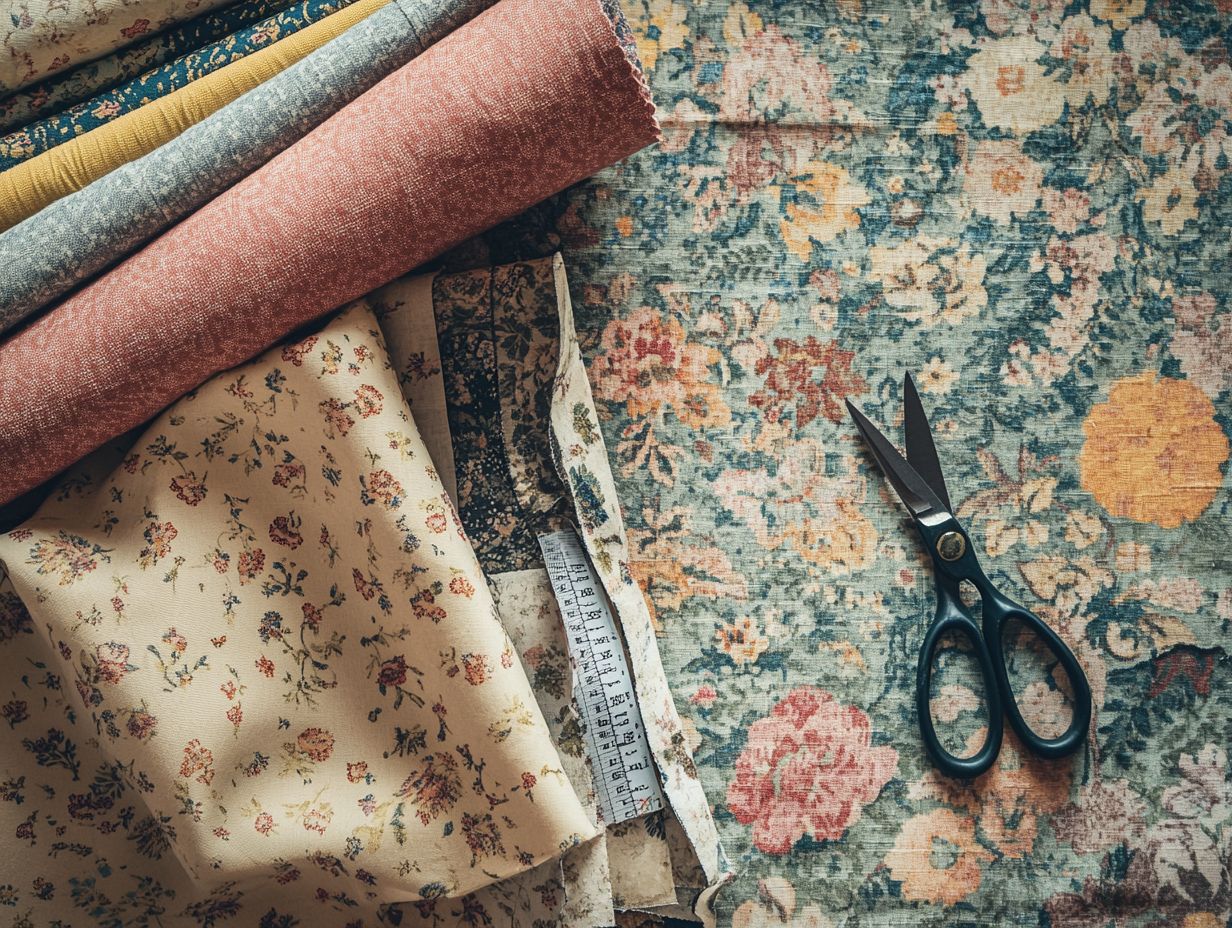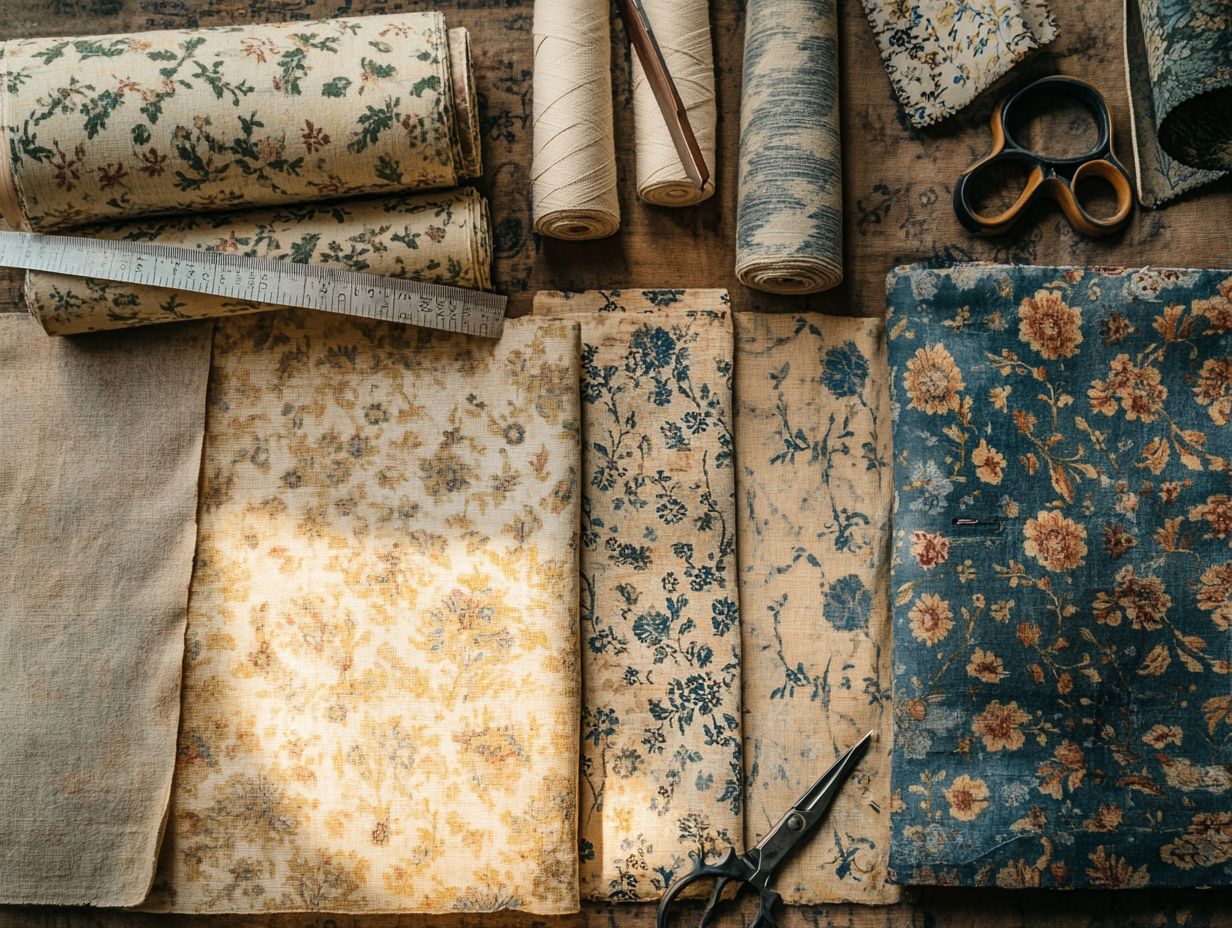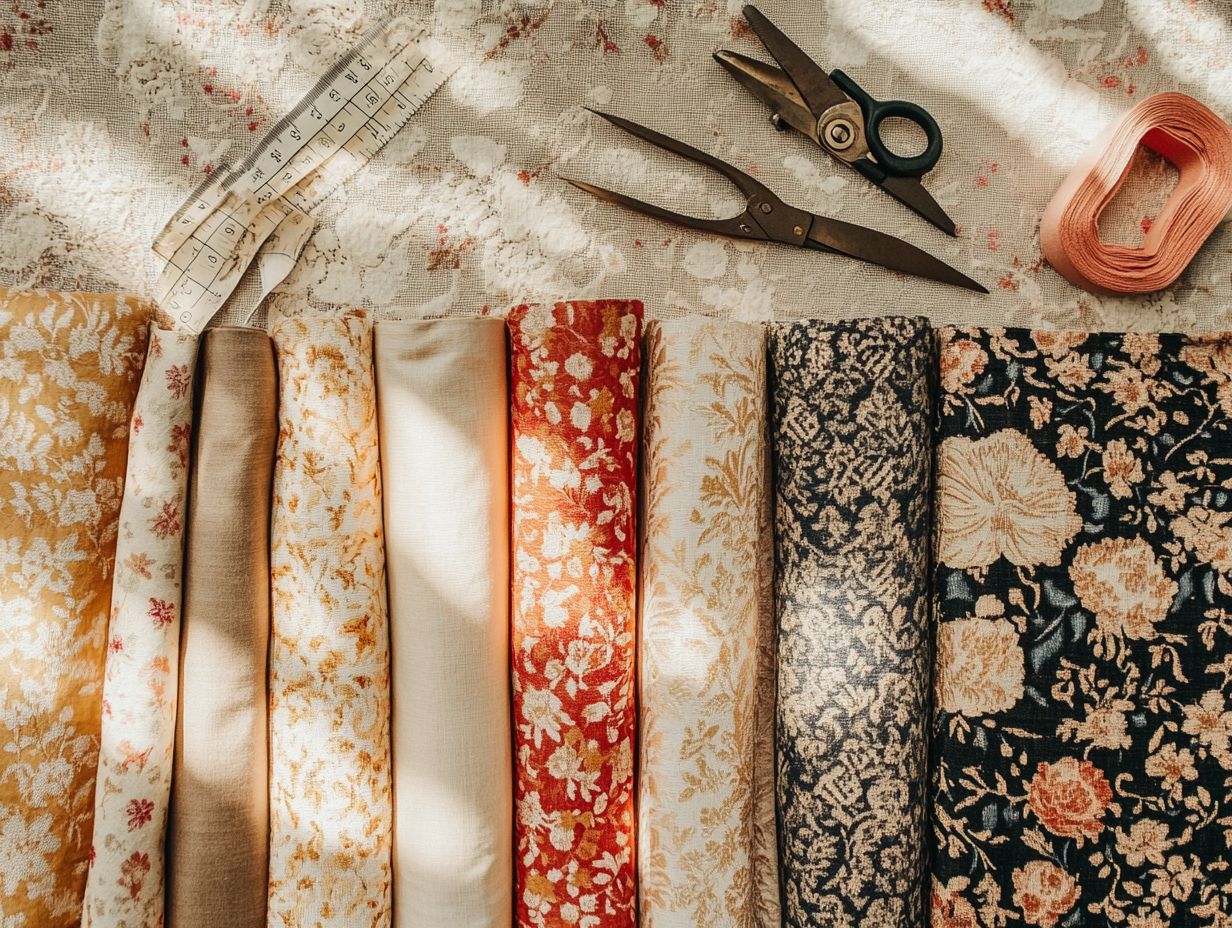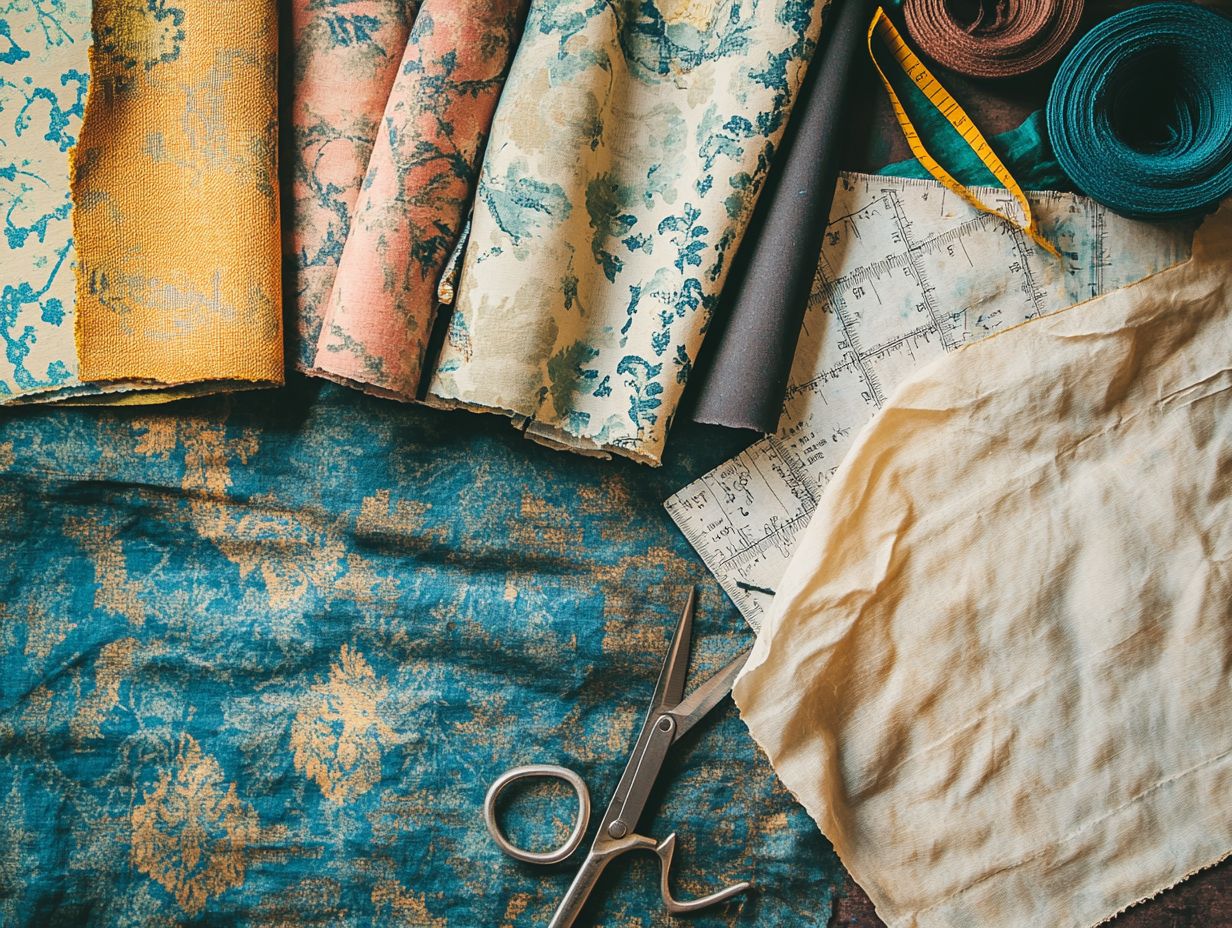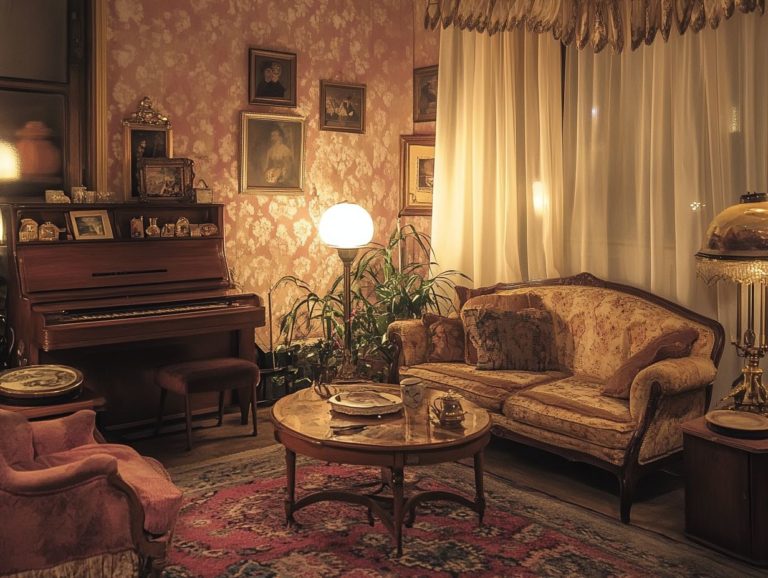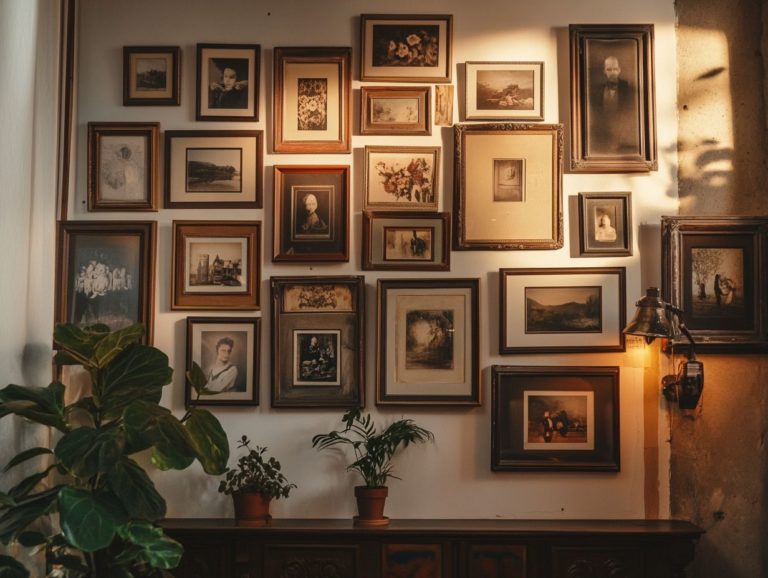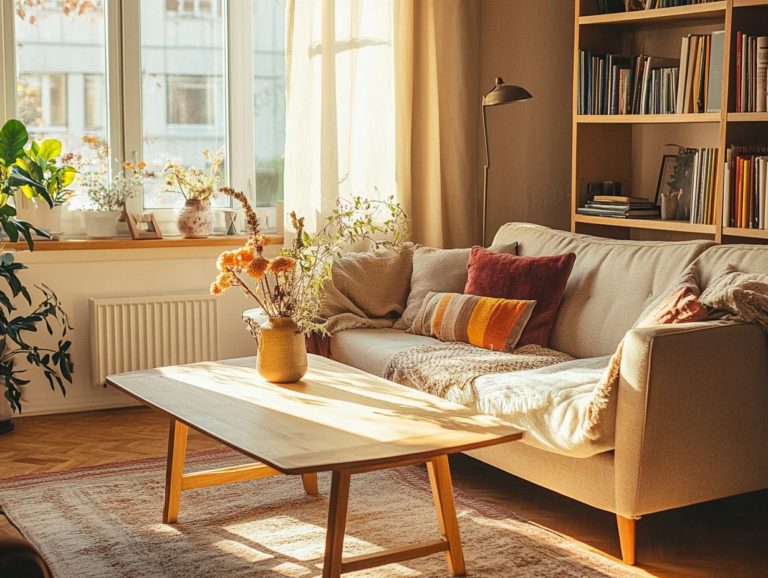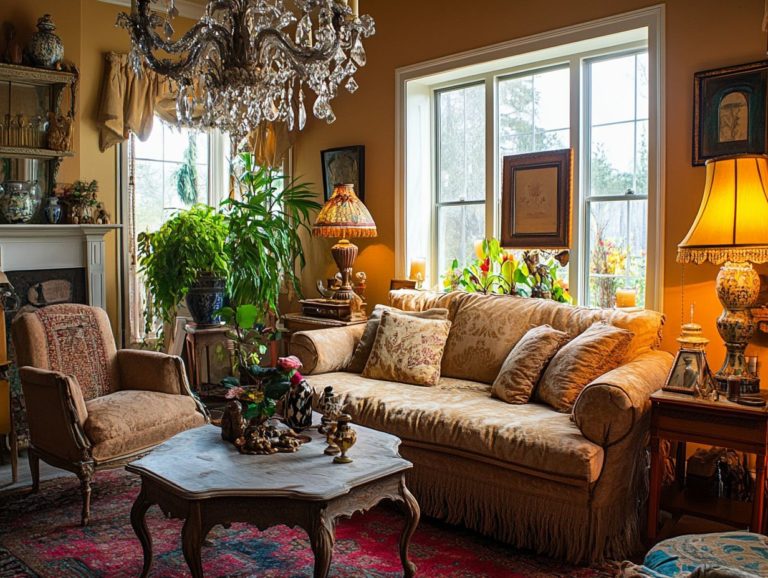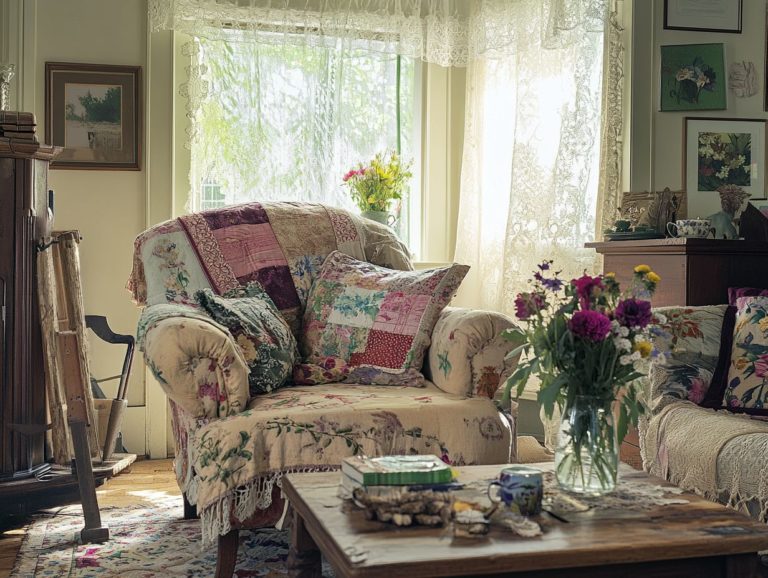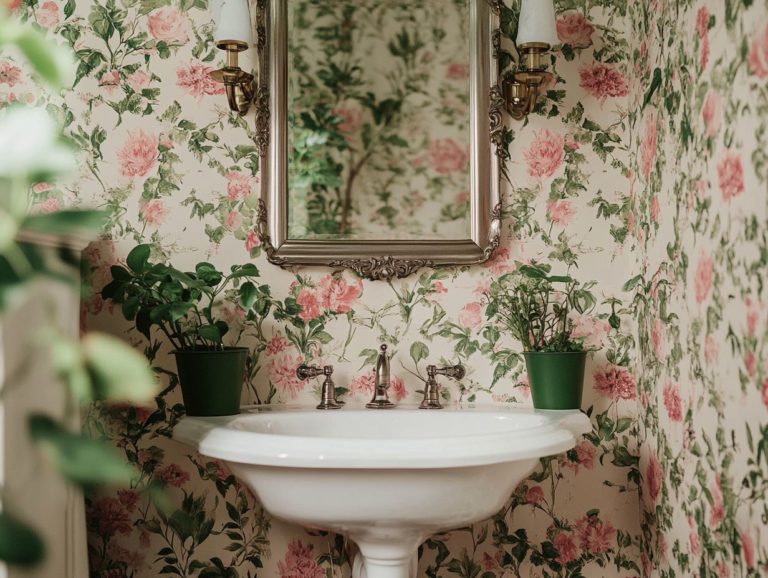How to Choose Vintage Fabric for Curtains and Upholstery
If you’re looking to add character and charm to your home, vintage fabric could be the perfect choice! Discover the charm of vintage fabric and how it can elevate your home decor!
This article explores what defines vintage fabric, its unique benefits, and the essential factors to consider when selecting the right pieces for your window treatments and upholstery.
From understanding quality and durability to discovering the various types available, this guide will help you find and maintain these timeless treasures.
Get ready to transform your space with vintage flair!
Contents
- Key Takeaways:
- Factors to Consider when Choosing Vintage Fabric
- Types of Vintage Fabric
- Tips for Finding and Purchasing Vintage Fabric
- How to Care for Vintage Fabric
- Frequently Asked Questions
- 1. How do I choose the right vintage fabric for curtains and upholstery?
- 2. Does the color of vintage fabric matter when selecting it for curtains or upholstery?
- 3. Are there any specific vintage fabric patterns that are better for curtains or upholstery?
- 4. How can I ensure the vintage fabric I choose is in good condition?
- 5. Can I mix and match different vintage fabrics for my curtains and upholstery?
- 6. Is it necessary to clean vintage fabric before using it for curtains or upholstery?
Key Takeaways:
- Check the quality and durability to ensure your vintage fabric lasts!
- Choose vintage fabric that complements your existing decor for a cohesive look!
- Properly clean and maintain vintage fabric to preserve its unique characteristics!
What is Vintage Fabric and Textiles?
Vintage fabric refers to textiles that possess historical significance. They are typically distinguished by their unique characteristics, rich textures, and intricate patterns, including popular vintage fabrics like cotton, silk, and wool. These fabrics encompass a variety of materials, including cotton, silk, and wool blends, each offering distinct aesthetic appeal for home decor and crafting projects.
Vintage textiles often represent specific styles, ranging from Victorian fabrics to mid-century designs. This makes them a highly sought-after choice among fabric enthusiasts and interior designers.
Originating from eras marked by artistic expression and cultural evolution, these materials convey narratives of the past while contributing to contemporary principles of sustainable design. This makes them ideal for crafting projects. Each piece exemplifies the craftsmanship of its time, with popular vintage fabrics such as damask, chintz, and tweed capturing the essence of their respective periods.
Incorporating these textiles into home decor enhances living spaces with vintage charm and aligns with an eco-friendly ethos, contributing to sustainable design. The utilization of vintage fabric can transform everyday items into unique furnishings that resonate with historical textiles and character.
Benefits of Using Vintage Fabric
The advantages of utilizing vintage fabric extend beyond aesthetics. They encompass contributions to sustainable design, exceptional durability, and the unique character that each piece can impart to projects. By choosing vintage textiles, you advocate for eco-friendly practices and introduce an artistic element to home decor that reflects historical significance and craftsmanship.
Incorporating vintage fabrics into interior design can significantly enhance the ambiance of any space, creating a rich tapestry that conveys a narrative with vibrant hues and intricate patterns. Each fabric selection can serve as a focal point, complementing vintage furniture and providing decorative flourishes that contemporary textiles often lack.
The craftsmanship inherent in these materials ensures quality and durability, allowing them to endure the test of time while exuding sophistication and warmth. Designers can curate an eclectic mix of patterns and textures, enabling a personal touch that distinguishes their projects in an industry frequently dominated by mass production.
Factors to Consider when Choosing Vintage Fabric
When selecting vintage fabric, consider several factors including the type of fabric, its characteristics, and its compatibility with existing decor. This ensures that the chosen textiles enhance the overall aesthetic of the space.
The quality and durability of the fabric are essential, as they determine its longevity and suitability for various crafting projects or upholstery applications, especially when considering performance fabrics.
Quality and Durability
Quality and durability are essential when selecting vintage fabrics. They influence how well textiles can withstand wear over time, especially in crafting or upholstery. Various durability tests can assess fabric strength, ensuring chosen vintage textiles maintain their integrity and aesthetic appeal.
Evaluating these characteristics is crucial for those bringing back the charm of the past in their décor or fashion choices. Materials like cotton, linen, and silk each have unique qualities—from breathability to resilience—that affect their longevity.
Conducting tests such as abrasion resistance (how well a fabric can withstand wear) and colorfastness (how well colors resist fading) provides valuable insights into how these fabrics perform under stress. This helps buyers achieve an optimal balance between aesthetic appeal and practicality when shopping for fabric. Understanding the specifics of fabric types helps ensure the vintage collection is visually appealing and durable for everyday use.
Design and Style
Design and style play a vital role in selecting vintage fabrics. They offer a variety of options that can significantly enhance the aesthetic appeal of any space. From elaborate historical patterns to distinctive designs inspired by different eras, these fabrics can be focal points or complementary elements in home decor.
Using these materials brings a delightful sense of nostalgia and allows for decorative flourishes that elevate the ambiance. By pairing vintage fabrics with thoughtfully selected vintage furniture, homeowners can create a cohesive look that tells a story through both textile weaves and design.
When chosen with care, vintage fabrics can transform spaces into warm, inviting environments that reflect personal style and appreciation for artistry!
Compatibility with Existing Decor
Make sure your vintage fabrics fit perfectly with your current decor for a stunning look! When integrating vintage fabrics, ensuring compatibility with existing decor is essential for a cohesive appearance that retains vintage charm.
Select vintage textiles that harmonize with vintage furniture and the established color palette for an artistic statement that reflects both historical significance and personal style.
It may be beneficial to explore contrasting styles. For example, pairing a bold floral vintage fabric with sleek modern furniture can create an artistic statement in your decor. This unexpected combination produces a delightful interplay of textures, adding depth to your space.
Consider incorporating trending home decor elements like muted neutrals or metallic accents as a backdrop for the vibrant patterns of vintage textiles. Pay attention to scale and color continuity to ensure selected pieces complement each other and resonate with the room’s ambiance.
Types of Vintage Fabric
The types of vintage fabric are varied, including:
- Cotton
- Silk
- Wool
- Vintage Lace
- Cotton blends
Each fabric has distinct characteristics and applications. These vintage textiles provide a wide array of options suitable for various design requirements, from upholstery to crafting projects, meeting fabric enthusiasts’ diverse needs.
Explore our collection of vintage fabrics today and find the perfect match for your project!
Popular Materials and Characteristics
Popular materials in vintage textiles include cotton, silk, wool, and vintage lace. Each material offers distinct characteristics that enhance both aesthetic appeal and functionality, with options like performance fabrics that are designed for durability.
These materials provide a diverse range of textures and unique properties that can elevate the overall style of interior decor, adding to the vintage charm of a space.
Cotton is renowned for its breathability and durability, making it an ideal choice for everyday items like curtains and cushion covers, especially in vintage projects.
In contrast, silk, with its luxurious sheen, adds sophistication to drapes and table runners, enhancing the vintage appeal of your home.
Wool is recognized for its excellent insulation properties, keeping spaces cozy with throws or rugs that resonate with vintage charm.
Vintage lace, characterized by intricate designs, can enhance any project as stunning overlays on various textiles, adding a touch of historical opulence.
Knowing well these unique qualities can assist crafting enthusiasts in selecting the right materials for their interior design schemes, ensuring the use of durable performance fabrics.
Tips for Finding and Purchasing Vintage Fabric
Acquiring vintage fabric can be a fulfilling adventure, particularly when exploring diverse sources like vintage fabric shops and online marketplaces such as Etsy, including popular shops like Lady Virginia Vintage in downtown Staunton.
By knowing where to search and what factors to consider in fabric shopping, enthusiasts can uncover distinctive textiles that align with their aesthetic preferences and project requirements.
Where to Look and What to Look For
When searching for vintage fabrics, it is essential to know where to look. Vintage fabric shops, flea markets, and online marketplaces like Etsy provide a wide array of options showcasing unique character and styles.
It is important to be discerning about the quality and condition of the textiles to ensure they meet your crafting and design requirements.
Local fabric stores specializing in vintage items offer an intimate shopping experience, often staffed by knowledgeable individuals who can help you make informed selections.
Antique shops often have hidden treasures, such as remnants or bolts of fabric that aren’t readily available elsewhere.
When evaluating these unique textiles, assess the fabric’s weight, texture, and color vibrancy. Look for materials that demonstrate durability and signs of previous craftsmanship.
Online communities and social media groups dedicated to fabric enthusiasts provide valuable opportunities to discover unique finds and firsthand reviews that can boost your confidence in purchases.
How to Care for Vintage Fabric
To keep your vintage fabric looking stunning, give it the special care it deserves! Caring for vintage fabric requires specific attention and techniques to ensure its longevity while preserving intricate patterns and rich textures.
A thorough understanding of appropriate cleaning methods and delicate care practices is essential for maintaining the beauty and integrity of these treasured textiles.
Proper Cleaning and Maintenance Techniques
Caring for vintage textiles is essential to keep them beautiful and lasting. Use gentle cleaning methods and steer clear of harsh chemicals to protect these treasures.
Different fabrics need specific care. Silk, for instance, should be hand-washed in cold water with mild detergent to prevent fading. Linen can be gently washed in a machine, while wool should be dry cleaned to keep its shape.
Make it a habit to check for any discoloration or tiny tears! Catching issues early can save your fabrics.
Store vintage pieces in breathable cotton bags to keep them safe from moisture and pests. This simple step ensures their beauty lasts for years.
Frequently Asked Questions
1. How do I choose the right vintage fabric for curtains and upholstery?
Consider the weight and durability. Heavier fabrics like brocade work well for upholstery, while lighter fabrics like linen are great for curtains.
2. Does the color of vintage fabric matter when selecting it for curtains or upholstery?
Yes, the color does matter! Consider the color scheme of your room and how the fabric will either complement or enhance it. Neutral colors are versatile and work well for both curtains and upholstery.
3. Are there any specific vintage fabric patterns that are better for curtains or upholstery?
There are no specific patterns that are better; it ultimately depends on your personal preference and the overall aesthetic of your space. Small, intricate patterns look great on curtains, while larger, bolder patterns can make a statement on upholstery.
4. How can I ensure the vintage fabric I choose is in good condition?
Inspect the vintage fabric carefully for any signs of wear, such as holes, tears, or discoloration. It’s also helpful to ask the seller about the fabric’s history and storage. If possible, request a swatch to test its durability before purchasing.
5. Can I mix and match different vintage fabrics for my curtains and upholstery?
Absolutely! Mixing and matching vintage fabrics can create a unique look. Just make sure the fabrics complement each other in color, pattern, and texture. Experiment with different combinations to find the perfect balance.
6. Is it necessary to clean vintage fabric before using it for curtains or upholstery?
Yes, it’s recommended to clean vintage fabric before using it, as it may have accumulated dirt over the years. Be cautious with delicate fabrics, and consult a professional if needed. Always check the cleaning instructions for specific fabrics before using harsh chemicals.

